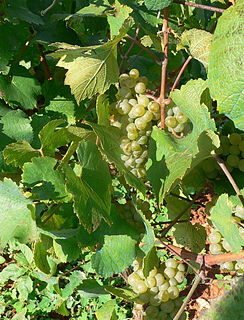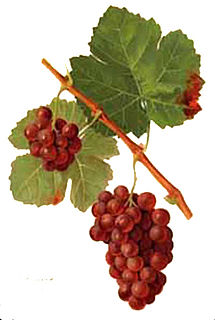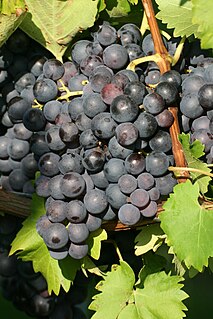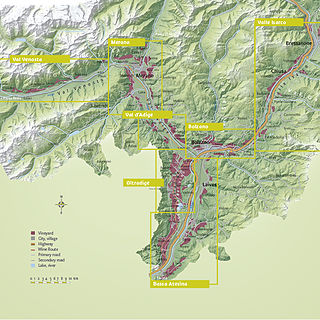
Malvasia is a group of wine grape varieties grown historically in the Mediterranean region, Balearic Islands, Canary Islands and the island of Madeira, but now grown in many of the winemaking regions of the world. In the past, the names Malvasia, Malvazia, and Malmsey have been used interchangeably for Malvasia-based wines; however, in modern oenology, "Malmsey" is now used almost exclusively for a sweet variety of Madeira wine made from the Malvasia grape. Grape varieties in this family include Malvasia bianca, Malvasia di Schierano, Malvasia negra, Malvasia nera, Malvasia nera di Brindisi, Malvasia di Candia aromatica, Malvasia odorosissima, and a number of other varieties.

Gewürztraminer is an aromatic wine grape variety, used in white wines, and performs best in cooler climates. In English, it is sometimes referred to colloquially as Gewürz, and in English and French it is written Gewurztraminer. Gewürztraminer is a variety with a pink to red skin colour, which makes it a "white wine grape" as opposed to the blue to black-skinned varieties commonly referred to as "red wine grapes". The variety has high natural sugar and the wines are white and usually off-dry, with a flamboyant bouquet of lychees. Indeed, Gewürztraminer and lychees share the same aroma compounds. Dry Gewürztraminers may also have aromas of roses, passion fruit and floral notes. It is not uncommon to notice some spritz.

Grüner Veltliner is a white wine grape variety grown primarily in Austria, Hungary, Slovakia, and the Czech Republic. The leaves of the grape vine are five-lobed with bunches that are long but compact, and deep green grapes that ripen in mid-late October in the Northern Hemisphere.

Müller-Thurgau is a white grape variety which was created by Hermann Müller from the Swiss Canton of Thurgau in 1882. It is a crossing of Riesling with Madeleine Royale. It is used to make white wine in Germany, Austria, Northern Italy, Hungary, England, Australia, the Czech Republic, Slovakia, Slovenia, New Zealand, Canada, the United States and Japan. There are around 42,000 hectares (104,000 acres) cultivated worldwide, which makes Müller-Thurgau the most widely planted of the so-called "new breeds" of grape varieties created since the late 19th century. Although plantings have decreased significantly since the 1980s, as of 2006 it was still Germany's second most planted variety at 14,000 hectares and 13.7% of the total vineyard surface. In 2007, the 125th anniversary was celebrated at the Geisenheim Grape Breeding Institute. Müller-Thurgau is also known as Rivaner, Riesling x Sylvaner, Riesling-Sylvaner (Switzerland), Johannisberg, Rizvanec (Slovenia) and Rizlingszilváni (Hungary).

Trollinger, Schiava, or Vernatsch, is a red German/Italian wine grape variety that was likely first originally cultivated in the wine regions of South Tyrol and Trentino, but today is almost exclusively cultivated on steep, sunny locations in the Württemberg wine region of Baden-Württemberg. It is primarily known under the synonyms Trollinger in Germany, Vernatsch in South Tyrol and Schiava in other Italian regions. As a table grape the variety is sometimes known as Black Hamburg, which is commonly confused with the similar synonym for Black Muscat—a variety that is actually a cross of Trollinger and Muscat of Alexandria.
Verduzzo is a white Italian wine grape grown predominantly in the Friuli-Venezia Giulia region of northeast Italy. It is also found in significant plantings in the Piave Denominazione di origine controllata (DOC) of the Veneto region, though some of these plantings may be of the separate Verduzzo Trevigiano variety. Verduzzo Friulano is used in varietal and blended wines, many of which fall under DOC as well as vino da tavola designations, that range in style from dry to late harvest wines. According to wine expert Oz Clarke, most of the sweeter examples of Verduzzo can be found in the Friuli-Venezia Giulia with the grape being used for progressively drier styles of the wine the further west into the Veneto.

Moscato Giallo or Yellow Muscat is a white Italian wine grape variety that is a member of the Muscat family of grapes. Known for its large deep cluster of loose, deep-yellow berries and golden colored wine, Moscato Giallo is grown mostly in northern Italy where it is most often used to produce passito style dessert wines. The grape is also planted in Croatia where it is known as Muškat žuti.

Dureza is a dark-skinned French wine grape variety from the Ardèche department of south central France in the Rhône-Alpes region. The grape is most widely known for being the father vine of Syrah—a discovery that confirmed that the Syrah vine was native to France and not introduced to the country from Persia, Sicily, Egypt or elsewhere, as had been speculated.
Uva Tosca is a red Italian wine grape variety that is grown in the Emilia-Romagna region of east-central Italy where it is the only grape variety able to grow in the higher elevations of the Val Secchia area. Despite what its name may allude to, ampelographers have little evidence to believe that the grape originated in Tuscany or has any close genetic relationship with the notable Tuscan wine grape, Sangiovese, that is also known under the synonym of Uva Tosca. In 2010, DNA analysis suggested that Uva Tosca may be a natural crossing between the Alto-Adige wine grape Schiava Grossa and Crepallocchi.
Biancame is a white Italian wine grape variety that is grown in the Marche and Emilia-Romagna regions of Italy. Here it is an important component in the Denominazione di origine controllata (DOC) wines of Bianchello del Metauro and Colli di Rimini.

South Tyrol is an autonomous province located in north-east Italy producing wine. This Austro-Italian wine region is noted for the distinct Austrian influences on the wine industry due to the region's long history under the rule of Austria-Hungary and Holy Roman Empires.

Nosiola is a white Italian wine grape variety that is grown in the Trentino region north of Lake Garda in the Valle dei Laghi. Here it is used in varietal Denominazione di origine controllata (DOC) wines and as a blending component in wines such as Sorni Bianco from Trento. It is also used to produce a dessert wine in the Vin Santo style from grapes that have been allowed to dry out prior to fermentation.
Rossola nera is a red Italian wine grape variety that has been growing in the Valtellina region of Lombardy since at least the 17th century. In 2004 DNA profiling determined that the grape has a parent-offspring relationship with the Piedmont wine grape Nebbiolo though which variety is the parent and which is the offspring is not yet clear. However, most ampelographers believe that Nebbiolo is likely the parent variety since written records in Piedmont have noted Nebbiolo being grown since at least the 13th century.
Rossignola is a red Italian wine grape variety that is grown in the Veneto wine region of northeast Italy. The variety was first mentioned growing in the province of Verona in the early 19th century and today is a permitted blending variety in several Denominazione di origine controllata (DOC) wines of the Veneto including Bardolino and Valpolicella.
Lagarino bianco is a white Italian wine grape variety that is grown in the Trentino-Alto Adige/Südtirol wine region of northeast Italy. It was once thought that the grape was a white berry color mutation or offspring of South Tyrolean grape Lagrein with a weiss Lagrien grape variety reportedly growing near the commune of Bolzano in 1318 but DNA profiling conducted in the early 21st century has shown that the two grape varieties are distinct with no direct relationship to each other.
Piccola nera is red Italian and Slovenian wine grape variety that is grown in the province of Trieste within the Friuli-Venezia Giulia wine region and across the border in neighboring Slovenia where ampelographers believe that the grape originated. Piccola nera, whose name means "little black", tends to produce to light bodied red and rosé wines that are meant to be consumed young. It is a permitted variety in the Denominazione di origine controllata (DOC) wines of Carso where it is usually blended with Terrano and in Venezia Indicazione geografica tipica IGT classification where the grape can be used to make varietal wines.
Trevisana nera is a red Italian wine grape variety that is grown in the Veneto region of northeast Italy. While ampelographers believe that the name Trevisana suggest that the grape originated in the province of Treviso, today the grape is almost exclusively found in the northern province of Belluno, particularly around the commune of Feltre, where the grape is a permitted variety in the Indicazione geografica tipica (IGT) zone of Vigneti delle Dolomiti.
Alionza is a white Italian wine grape variety that is grown in the Emilia-Romagna region of north central Italy, where it has a long history of being used since the 14th century as both a table grape and blending grape for wine production. While sometimes confused with the Greek wine grape Sklava, DNA analysis in the early 21st century has suggested, instead, that Alionza may be closely related to the Tuscan wine grape Trebbiano.
Bianchetta Trevigiana is a white Italian wine grape variety that is grown in the Trentino-Alto Adige/Südtirol and Veneto wine regions of northeast Italy. Here the grape is rarely used a varietal but, instead, is a permitted blending grape adding acidity to the wines of several Denominazione di Origine Controllata (DOC) zones including the sparkling wine Prosecco and has also been used for vermouth production. The name Trevigiana is derived from the province of Treviso where the grape is believed to have originated from.
Bonda is a red Italian wine grape variety that is grown in the Aosta Valley region of northwest Italy around the communes of Châtillon and Quart. Historically the grape has been confused with another grape of Aosta, Primetta, but DNA analysis in the early 21st century showed that the two grapes were distinct and not closely related. Despite being known under the synonym of Prié rouge, Bonda is not a color mutation of Prié blanc nor do the two grapes seem to be closely related.










